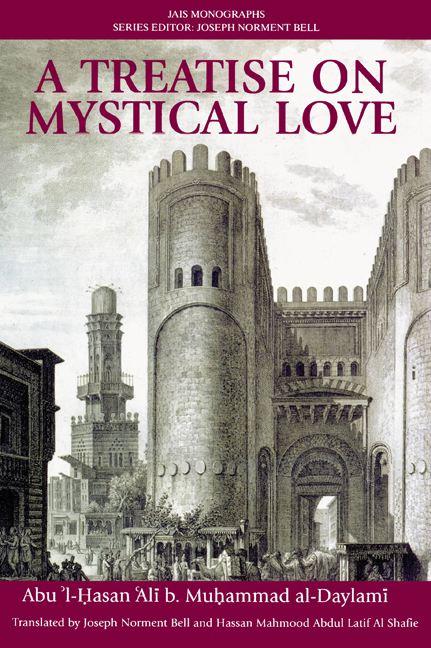Book contents
- Frontmatter
- Contents
- Dedication
- Acknowledgments
- Introduction
- Manuscript title page in English
- Author’s Preface
- I On the Chapters of the Book
- II May the Word cIshq Be Applied to Love for God and from God?
- III Preliminary Considerations
- IV On the Word Love, Its Derivation, and Its Meanings
- V On the Origin and Beginning of Love and Eros
- VI On the Essence and Quiddity of Love
- VII On the Diverse Views People Hold about Love
- VIII On the Description and Character of Eros
- IX On Praiseworthy Love
- X On Those Who Disparaged Love for Some Cause
- XI On the Effects of Love [and Eros] and Their Signs and Symptoms
- XII On the Signs of Love, Including the Sayings of Unimpeachable Spiritual Authorities among the Mystics and the Righteous
- XIII On the Classification of Love according to Our Opinion
- XIV On the Signs of God’s Love for Man
- XV On the Explanation of the Signs of Man’s Love for God
- XVI On the Signs [of the Love] of Those Who Love One Another in God
- XVII On the Love of the Elite among Believers
- XVIII On the Love of the Commonality of Muslims
- XIX On the Love of All Other Animate Beings
- XX On the Meaning of the Word Shahid
- XXL On the Definition of the Perfection of Love
- XXII On Those Who Died of Natural Love
- XXIII On Those Who Killed Themselves for Love
- XXIV On the Death of Divine Lovers
- Bibliography
- Index of Persons, Peoples, and Places
VIII - On the Description and Character of Eros
Published online by Cambridge University Press: 01 October 2020
- Frontmatter
- Contents
- Dedication
- Acknowledgments
- Introduction
- Manuscript title page in English
- Author’s Preface
- I On the Chapters of the Book
- II May the Word cIshq Be Applied to Love for God and from God?
- III Preliminary Considerations
- IV On the Word Love, Its Derivation, and Its Meanings
- V On the Origin and Beginning of Love and Eros
- VI On the Essence and Quiddity of Love
- VII On the Diverse Views People Hold about Love
- VIII On the Description and Character of Eros
- IX On Praiseworthy Love
- X On Those Who Disparaged Love for Some Cause
- XI On the Effects of Love [and Eros] and Their Signs and Symptoms
- XII On the Signs of Love, Including the Sayings of Unimpeachable Spiritual Authorities among the Mystics and the Righteous
- XIII On the Classification of Love according to Our Opinion
- XIV On the Signs of God’s Love for Man
- XV On the Explanation of the Signs of Man’s Love for God
- XVI On the Signs [of the Love] of Those Who Love One Another in God
- XVII On the Love of the Elite among Believers
- XVIII On the Love of the Commonality of Muslims
- XIX On the Love of All Other Animate Beings
- XX On the Meaning of the Word Shahid
- XXL On the Definition of the Perfection of Love
- XXII On Those Who Died of Natural Love
- XXIII On Those Who Killed Themselves for Love
- XXIV On the Death of Divine Lovers
- Bibliography
- Index of Persons, Peoples, and Places
Summary
Section One. The Opinions of the Belletrists
Al-Nāshiʾ was asked to describe love and he said: “Love is divided into three parts: love for the soul, love for form, and love for movement. It is love for the soul that most completely comprehends the aspects of love and is the farthest removed from bother and weariness. Love for form is the sweetest to the senses and the most delectable to the sight. Love for movement is the most graceful to the glance and the most painful to the heart. However, love for form and love for movement are in most cases subordinate to love for the soul, even though they may at times occur independently. Thus one does not fall in love with a pictorial form, for there is no soul in it, nor any movement, [110] nor does one love lethargic eyes, for there are no glances in them.”
Al-Nuʿmān b. al-Mundhir asked al-Zarqaʾ bint al-Khussabout eros and she said: “It is of several varieties. One is madness, one is tenacity, and one is affectation. As for that which is affectation, it does not endure, and time effaces it in short order. It has no permanence, and affection for one loved in this way is not observed for long. As for that which is tenacity, in the beginning it is slight, but it becomes a mighty passion. When it gains a firm foothold, it grows as a fire grows when fed an abundance of firewood. As for that which is madness, it is a hidden malady and an oppressive burden that is relieved only by the expiration of one's appointed time.”
A certain man of letters described eros saying: “The way by which it comes in is hidden from the eye, and the way by which it proceeds lies veiled in the heart. The tongue cannot describe it, nor can eloquence portray it. It is something between magic and madness, obscure where it moves and hides.”
Similarly, a Bedouin once described eros as follows: [111] “Too hidden to be seen, too glorious to be hidden. It lies concealed like fire in stone: if you strike the stone, it sparks; if you do not, the fire remains unseen.”
- Type
- Chapter
- Information
- A Treatise on Mystical Love , pp. 84 - 87Publisher: Edinburgh University PressPrint publication year: 2020



